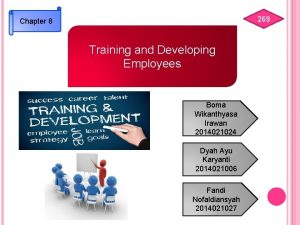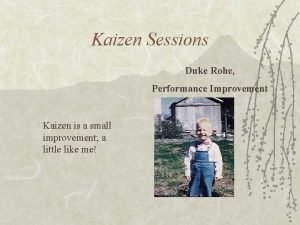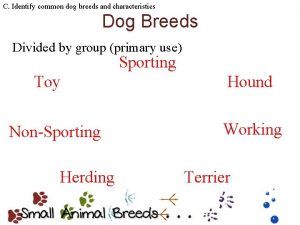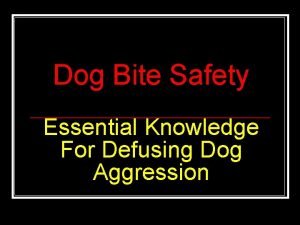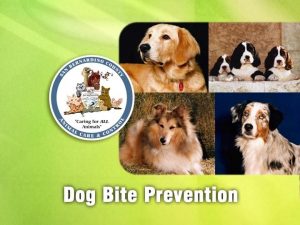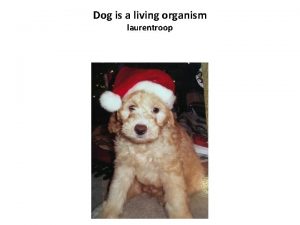Designing Developing and Delivering Dog Training Sessions TIME






















- Slides: 22

Designing, Developing and Delivering Dog Training Sessions

• TIME TO START THINKING ABOUT YOUR OWN TRAINING CLASSES! • Starting as you mean to go on is so important • This lesson will look at the designing and development stages of dog training classes, and one to one sessions – • Later we will look at delivery & policies

• This module will focus on giving you pointers while you think about the classes yourself • The goal here is to start working toward our practical training day • You will be … one to one session, , with report • Group training class presentation

• Start thinking about the future! • Goal of this module – more experience (you should be finishing your work experience hours shortly) • Focusing on implementing your new knowledge to real world • Boost your confidence in your ability • Think outside the box when preparing your courses

• Your future career • Standard route – group classes or one to ones • Other options – training working dogs (assistant, sniffer) • Specialising in an area (ringcraft, agility etc. ) • Progressing to behaviour work – build your ability

Start thinking design and development • What is important when you design your content? • Your audience! who are they • whats their ability – physically and mentally • Culture / social demographic / current trends • Language barriers • Frustration levels • What is their goal (never mind yours!) • To provide best service to them!

Know your audience – how? • Check in with them – form, phone q and a? • Check in regularly throughout your session – ‘does this make sense’ ‘am I explaining this right’ ‘what do you think’ • Feedback from past clients

• To become a GOOD professional trainer you need to • Understand learning theory • Understand the dog biologically (nervous system SNS etc. areas of the brain (and why they matter) the dogs ethology, understand behaviour THEN • KNOW YOUR CONTENT!!! • SO! This means you should know the step by step, and how to deliver, every behaviour you will teach fluently!

• By the practical day I should be able to say ‘sit / down / leave it and you can teach it immediately! • Your built up knowledge should equip you with the ability to train un-prepared behaviours • You are providing a service, you should be good at it! • Your knowledge is your product • You have been given lots of training plans, but begin preparing more! • Remember to work on the 3 D’s

• BUT! Know what you don’t know! You don’t need to know everything • I know I’ve said it before – but you’re not a vet ; ) refer!

Know what resources you need when preparing for your classes • Environmental – heat, flooring, light, parking, location • Food rewards? Dog allergies? Human allergies • Spare leads? • Up-selling? • Clickers • Visual barriers? • What can you steal from your work exp?

Know your risks • Very important – this industry is high risk. INSURANCE • Think of them, prep for them, minimise them • Dog-dog risks • cross contamination of diseases • fighting • impregnation(!) • causing dog-dog fearful behaviours

• dog-human risks • Bite from client’s dog to trainer • Bite from dog to another class attendee • Trips from dog getting underfoot • Dog leash (particularly flexi leash) tangling up a person as dog moves around • Class member (particularly children) may mistreat another clients dog • Slips, trips and falls, particularly strong dogs pulling handler over • Injuries from mis-handling of leash

• Trainer risks • Victim of crime – particularly if alone during training session • Injury or bite from dog • Slips, trips and falls • Environmental risks • Fire • Electrical burns • Injury from sharp objects, and location specific injuries.

• Prepare for Unexpected Events • When designing your class or one to ones take time to predict, and prepare for, any unexpected events. • Client contact details • Spare keys? • First aid training? • Policies in place for clinets mistreating dogs • Power cuts etc.

Progression and retention • Know your progression – advanced class offered at end of first • Retention follow up – check in to see how success was or do they need more • Long-term relationship – can you cross sell or create a longtime client

Know your Industry • Get to know local groomers, vets, pet shops • Be knowledable of legislation, industry trends, tv shows etc • Know responsible ownership – chipping, ID tags, dog licence, BSL, no roaming • Have a basic understanding of vaccinations, neutering, regulating weight, good welfare, breed traits

Getting Started • Educated decision on content • Know your premises • Know your market • Know what they want • Design your class Start Task Step Details Time by Step Safety Teaching/ Resource Delivery s Methods Required

Training a behaviour in class • Name behaviour • Explain goal • Think about the benefits (or let clients come up with examples) • Break into steps, and discuss in general • Go back to step one, explain again • Demo with dog • Recap and leave with tag point

• Client practices – manage your distance • Maybe help with the client by demo again • Ask (one to one) any questions • Move on to stage 2 • Recap verbally • Demo • Leave with tag teach • Client practice , you assist • Try stage 3 but often that requires homework

• REMEMBER THIS FOR YOUR ASSESSMENT!!

Now get Writing • Research • Lesson plan • Homework handouts and / or videos • Next we will look at how to deliver your classes, how to focus on one to one sessions and how to create policies and procedures to help your classes run smoothly
 -is not one of the purposes for giving oral presentations.
-is not one of the purposes for giving oral presentations. Designing and developing effective hrd programs
Designing and developing effective hrd programs Hrd design
Hrd design Personal pronouns complement
Personal pronouns complement Designing and evaluating training system
Designing and evaluating training system Chapter 8 training and developing employees
Chapter 8 training and developing employees Chapter 8 training and developing employees
Chapter 8 training and developing employees Building and delivering customer value and satisfaction
Building and delivering customer value and satisfaction How to conduct a jad session
How to conduct a jad session Hkn review session
Hkn review session Listening session template
Listening session template Academic success center tamu
Academic success center tamu Asn scientific sessions
Asn scientific sessions Dr charles severance
Dr charles severance Webex event breakout rooms
Webex event breakout rooms Rolling stones satanic sessions
Rolling stones satanic sessions #sessions with conversions
#sessions with conversions Kaizen sessions
Kaizen sessions Data analysis, interpretation and presentation
Data analysis, interpretation and presentation For minutes. start.
For minutes. start. Central training room
Central training room Manuscript for speech
Manuscript for speech How to deliver entertainment speech
How to deliver entertainment speech






